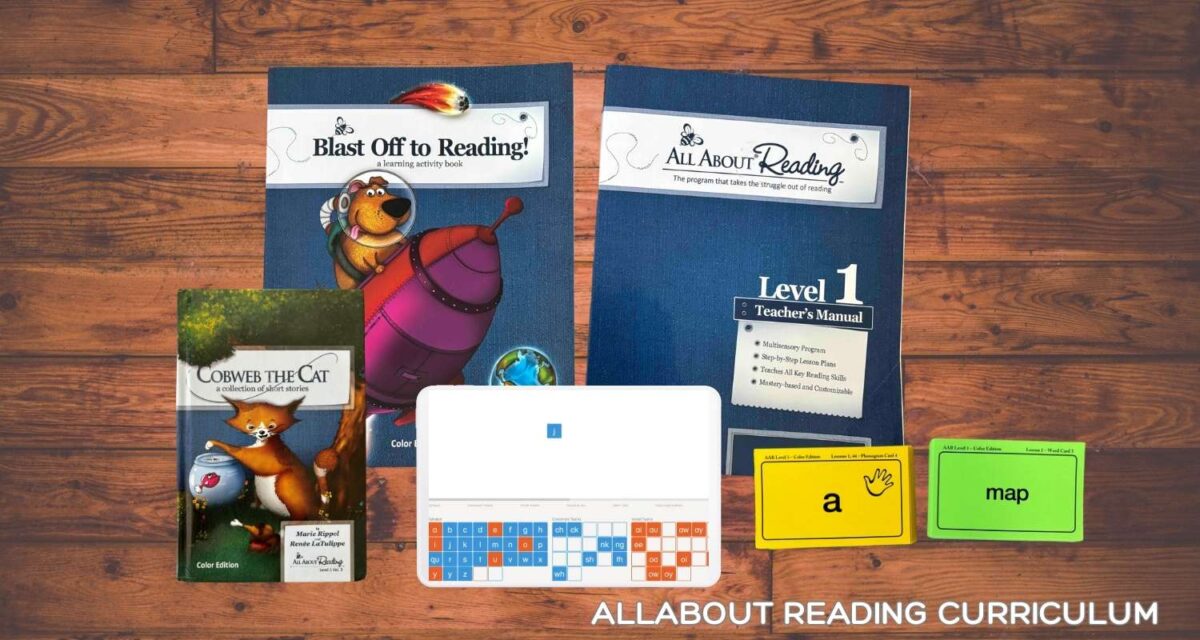*Affiliate Disclosure: Some of the links included in the article might be affiliate links, meaning that I could get a small commission, at no additional cost to you, if you buy from them.
Teaching your child to read feels like a daunting task, right?
Stakes are high – Learning to read is one those key foundational skills that will set the stage for their entire educational journey… However, if you are just getting started with homeschooling, you probably have no idea how to do it!
No wonder homeschooling parents feel so much pressure to choose “just the perfect reading curriculum.”
To add even more pressure to this decision, there are just too many programs available, each promising to be the magic bullet… But, how do you know which one will truly resonate with your child and set them on the path to reading success?
If you are in research mode right now, you’ve probably heard of All About Reading. This homeschooling curriculum keeps popping up as an extremely popular choice.
Why? What makes this literacy program so special?
In this in-depth review, we’re going to take a close look at All About Reading (AAR).
By the time you finish this article, you’ll have a crystal-clear understanding of AAR’s structure, what the lessons look like, and whether this curriculum is the perfect fit for your homeschool.
So, let’s get started!
DOWNLOAD MY NOTES FROM THE ARTICLE AVAILABLE!
This article is packed with valuable information to help you understand the All About Reading curriculum.
Of course, you are welcome to re-read it as many times as you need, but I have also created a handy “Download My Notes Document!,” you can refer to with the KEY POINTS from the article!
What is All About Reading? Understanding the All About Reading Approach
So, what is All About Reading?
At its heart, All About Reading (AAR) is a phonics-based, multisensory reading program.
It’s structured, systematic, and follows a “no gaps” approach, meaning it leaves no phonics concepts in the air in the -oftentimes “wishful”- thinking that children will just figure things out all by themselves. Everything is covered, and no stone is unturned in All About Reading! It’s a super explicit curriculum.
All About Reading places a strong emphasis on phonemic awareness, the ability to hear and manipulate sounds in words – a crucial skill for becoming a reader.
All About Reading is based on the Orton-Gillingham (OG) approach to teaching reading.
Let’s get only a bit technical here, so you have an understanding of what following this approach really means, since you’ve probably heard a lot about it – again so many rave about it!
The Orton-Guillingham (OG) approach is phonics-based, meaning it focuses on the relationship between sounds and letters.
It’s also structured, systematic, and cumulative, building skills in a logical order. The OG method also incorporates multisensory teaching techniques, engaging visual, auditory, and kinesthetic learning pathways to reinforce learning. For example, this might involve using letter tiles to build words, so students can see and touch the phonograms as they learn, or using hand motions to help reinforce the sounds of vowels.
This approach can be particularly beneficial for students with dyslexia, but its explicit and sequential nature makes it effective for all learners.
If you want to learn even more about the Orton-Guillingham approach to teaching reading, we have an entire article about it! Read the article here!
What’s in the Package? A look into All About Reading Level 1
To get started with AAR Level 1, you’ll need a few key materials:
- Teacher’s Manual – Level 1: This is your step-by-step guide on how to teach each lesson. Get familiar with the system, follow the instructions (lessons are scripted), and that’s it!
- Student’s Activity Book: “Blast Off to Reading”: This workbook is where your child will practice and reinforce the reading skills you’re teaching. In the teachers’ manual, it’ll tell you the activities from the workbook for the lesson you are at.
- Flashcards: You’ll use both yellow and green flashcards throughout the program to review and build fluency. The green cards are your word cards, and the yellow cards are your phonogram cards – these colors help you quickly organize and review different types of concepts in the lessons. However, I will explain this in more detail later on.
- Phonetically Decodable Readers: Their readers have been designed to practice reading in a controlled and gradual way, building your child’s confidence and making sure the text matches the reading level your child is at every step of the way.
- Phonogram Tiles or Letter Tiles App: These manipulatives help your child visualize phonograms (letters or letter combinations representing sounds). You can choose between physical tiles or the app.

While you’ll need to purchase new levels of the other materials, the phonogram tiles or app are a one-time investment for all AAR and All About Spelling levels.
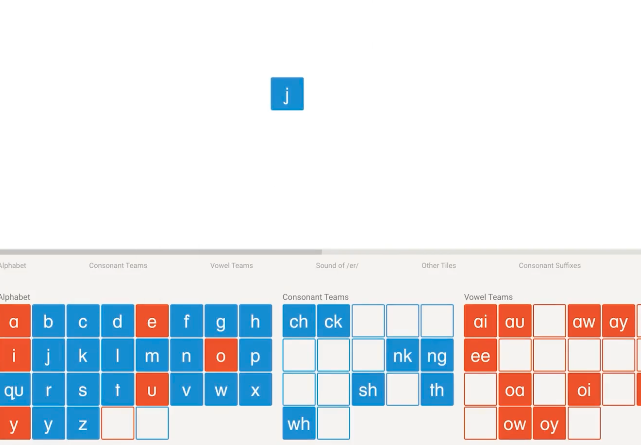
Cracking the Code: Understanding All About Reading (AAR) Lessons
Before you begin with Level 1, your child should have a few basic skills.
For instance, your student should display letter knowledge, should be able to recite the alphabet song, should recognize recognizes the capital letters, etc.
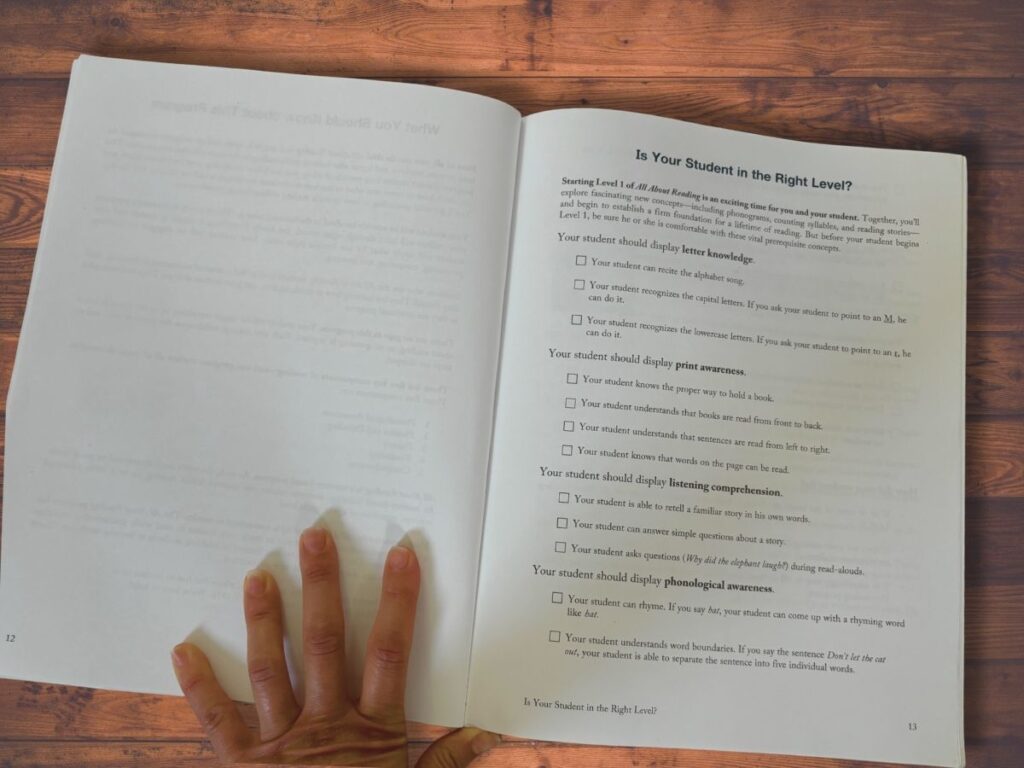
You have all required skills listed on Teachers Manual. However, don’t worry, you don’t need to buy the program just to realize that maybe that wasn’t the right level for your kid!
You can do a placement test on their website! In fact, I think it’s a really good idea to go ahead and take it almost for every kid that is just starting out with All About Reading. Why? Level numbers do not correspond with grade levels!
All About Reading Lesson Structure
So, what does a typical AAR lesson look like? It’s broken down into five parts:
- Before You Begin: This section explains the lesson objectives, lists the materials you’ll need, and provides helpful teaching notes. It gets you fully prepared for the instruction ahead.
- Review (not applicable in the first lesson): In subsequent lessons, you’ll review previously taught phonograms and reading skills, reinforcing that learning.
- New Teaching: This is where the magic happens! You’ll introduce new phonograms, following the script provided. The program integrates multisensory teaching techniques, like hand motions for vowels, using the phonogram tiles or games, to make learning stick. Generally, your kid will also do some activities from the students’ book and and will practice reading words, phrases, or sentences. For this, you’ll word cards (green flashcards) and “fluency practice sheets” from the students book.
- Read Aloud-Time: Set aside 10-20 minutes to read a story. If you wish to do so, you can keep track of your read-alouds in the provided Read-Aloud record.
- Track Your Progress: Have your student mark the lesson he/she’s just finished on the Progress chart, using stickers provided.
Let’s Get Real: A Peek Inside a Lesson
Okay, let’s get real – what does an actual lesson from Level 1 look like? Let’s see inside lesson ONE! (Please note that in Lesson 1, there isn’t a Review Part as we are just getting started!)
In the “Before You Begin” part (cream-colored), you’re given a crystal-clear overview of the lesson and a handy list of the materials you’ll need, so you have them ready for the lesson.
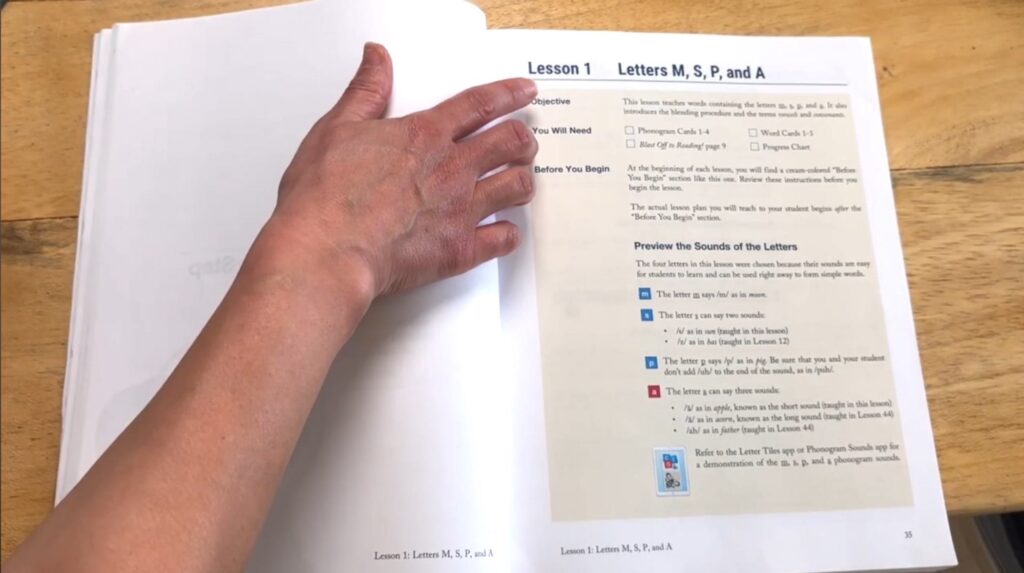
So, in this case. We need:
- Phonogram cards 1 to 4
- Blast off to Reading page 9
- Word cards 1 – 3
- Progress Card
The New Teaching part introduces the phonograms “m,” “s,” “p,” and “a,” along with their corresponding sounds and clever hand motions for the vowel sounds.
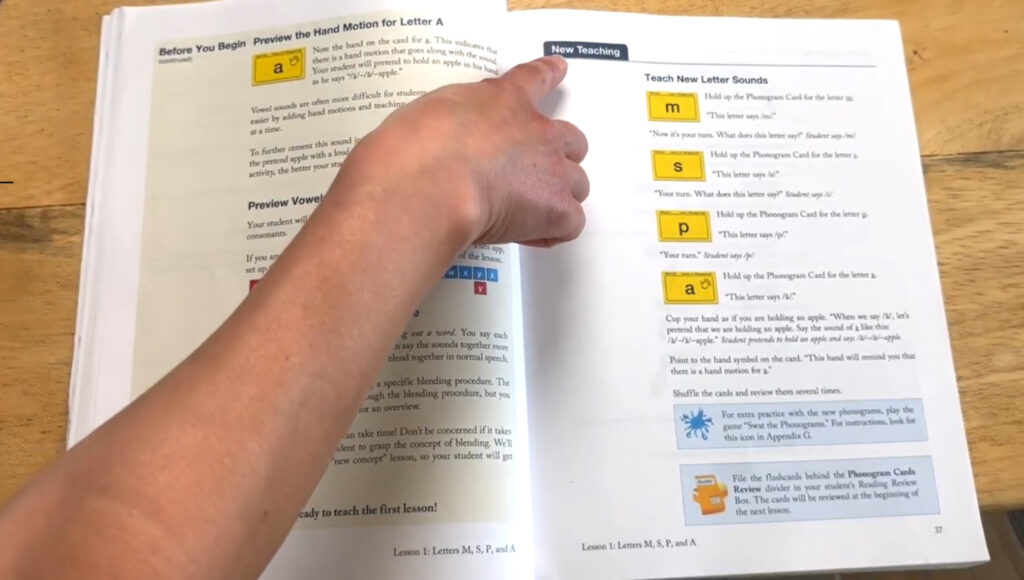
Within this part (by far, the longest of them all!), not only will you introduce new sounds, but you’ll also get your child to practice with them.
For instance, by blending sounds, playing “change-the-word” or getting him/her to read words on the word cards.
Next Part: Read-Aloud Time
At this point in the lesson, you’ll read aloud to your child for 20 minutes. You can keep track of your read-alouds on the Read-Aloud Record found on page 7 of the activity book.
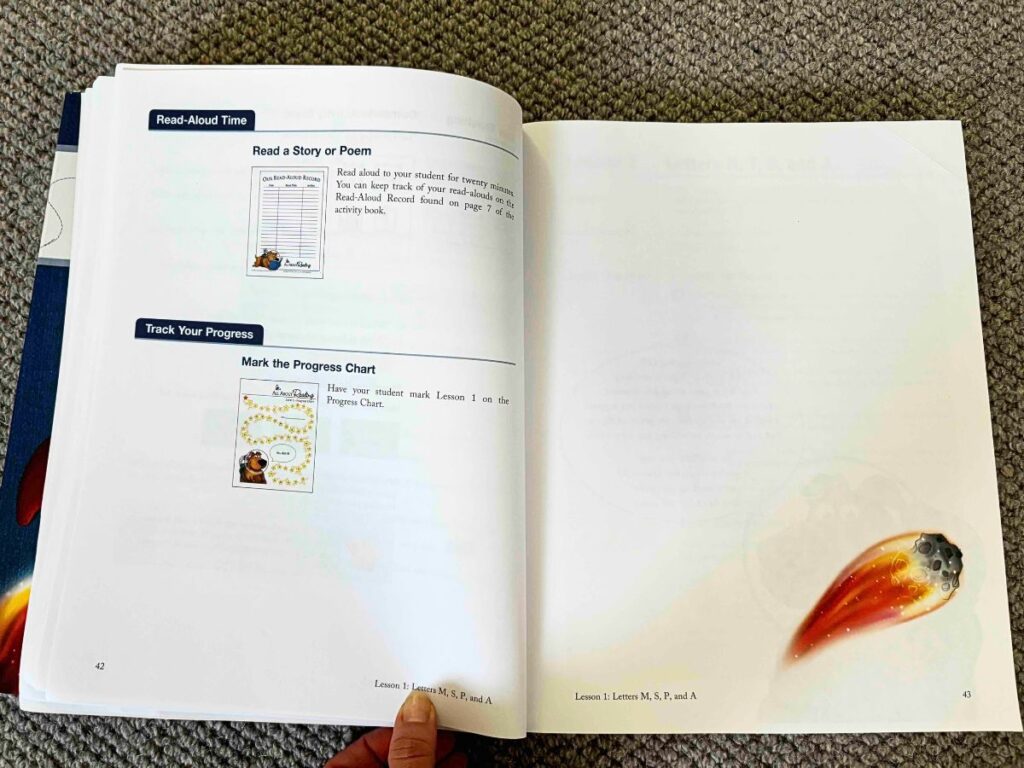
Reading to your child is crucial, even as they begin reading basic sentences from the practice sheets or readers.
In fact, reading aloud should continue for a long time. This builds their vocabulary, comprehension, and background knowledge, setting them up for future reading success.
Part #5: Track Your Progress
Finally, track your progress – that’s where the stickers come in. Easy!
Still have doubts about the structure of a lesson in All About Reading?
If you want to see inside an All About Reading lesson even closer, watch this flip-through on YouTube. I think that will clarify things fully!
Navigating through All About Reading Lessons
I know what you might be thinking: “This looks complicated and so long.” While it may take you some time to get used to the lessons, don’t feel overwhelmed. The instructions are detailed to support you.
The key is to get familiar with their structure, method, and terminology.
As for the lesson length, yes, these are long lessons! But don’t feel pressured to complete a whole lesson in one sitting. In fact, the authors of the curriculum say that ideally lessons shouldn’t last any longer than 20 minutes.
So, simply do a 20-minute lesson, and pick up where you left off the next day.
The read-aloud time can happen at a different point in your day, like right before bed.
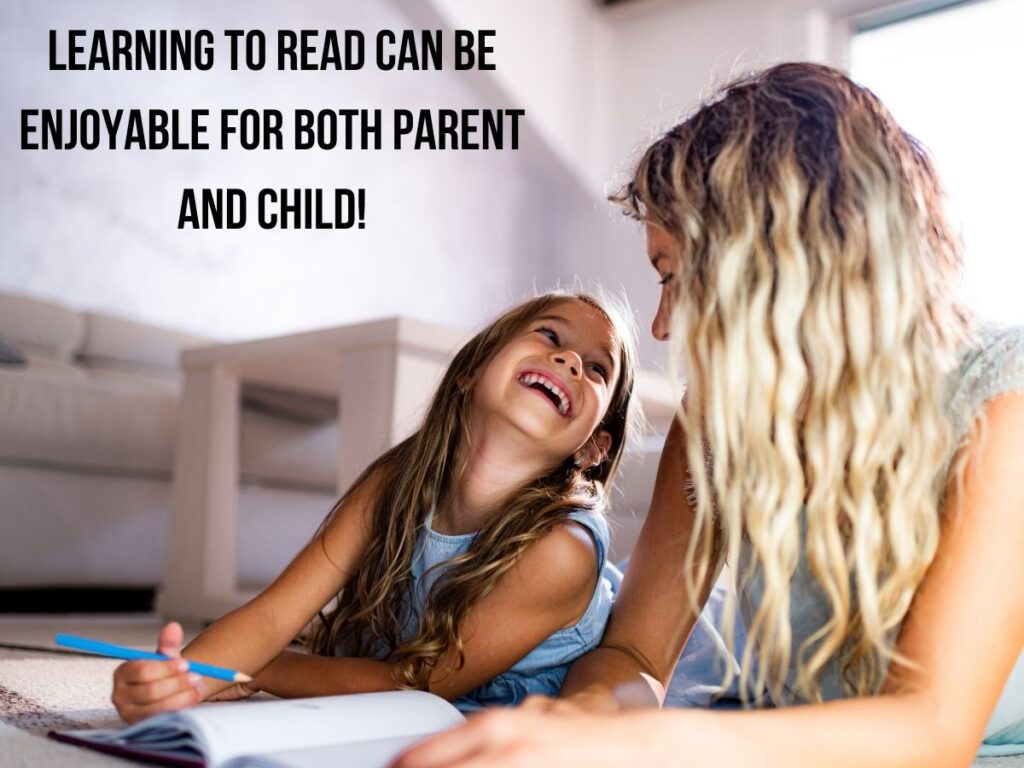
The Importance of Read-Alouds in the Program
Reading aloud to your child is a crucial part of the All About Reading program.
In fact, it’s so important that it’s included as a reminder at the end of every lesson.
As they explain in the Teachers’ Manual…
Reading aloud for just 20 minutes a day may not seem like a lot, but the cumulative effect is significant. Over five years, that’s 600 hours of read-alouds, leading to huge gains in vocabulary, comprehension, and background knowledge.
How much does All About Reading Cost?
The prices for All About Reading vary by level and the specific materials you need. This is a rough breakdown for level 1:
The full package including one Teacher’s Manual, one Student Packet (Activity Book, Flashcards, Stickers), and three readers costs $159.95 at the time of writing this article. On top of that, you’ll need to buy their physical Letter Tiles (one-off purchase for all levels), which costs $25.95 at the time of writing this article.
If you decide to use the Letter Tiles app instead of the physical tiles, it is priced at $19.99, again at the time of writing this.
Take a look at the most up-to-date prices on their site.
You can also get the materials individually. For instance, if you’ve already used this curriculum with your older kids, and only need their activity book; or if you’ve lost some materials.
While I know this curriculum can be costly for some families, it is a high-quality one too, and they offer an outstanding one-year no-questions-asked money-back guarantee!
Learn more about their guarantee here!
How many levels does All About Reading have?
The program is divided into seven leveled stages, each building upon the previous one to progressively develop reading proficiency.
It will take your child from foundational reading concepts (such as phonemic awareness, blending and basic comprehension) all the way up to sophisticated reading skills, in-depth analysis, and independent reading proficiency.
Please bear in mind that level numbers do not correspond with grade levels!
If you are not sure about the right level for your child, go ahead and take their placement test!
The Million-Dollar Question: Is AAR Right for You?
AAR provides a logical, systematic approach to teaching reading. It’s a perfect fit for parents who want a structured program with minimal prep time.
The multisensory instruction and gradual release of responsibility support various learning styles. However, the need to purchase new materials for each level and the initial investment might be a consideration for some families.
If you’re interested in learning more, AAR offers sample lessons and freebies on their website. These resources can help you further assess the program’s fit for your child.
By understanding All About Reading curriculum’s underlying philosophy, components, and approach, you can make an informed decision, setting your child up for reading success.
I hope this article has helped you with that!
Remember you can download my notes here!
If you’re still unsure, take our Discover Your Ideal Curriculum quiz to find the best reading curriculum for your preferences.

Hey there! I’m Laura – an author, YouTuber, blogger, and the creator of the “Learning Reading Hub” platform. I created this space to dive into the world of reading instruction and to shout from the rooftops about how vital it is to use the right methods for teaching reading. I’ve got a TEYL certification (Teaching English to Young Learners), plus a Journalism degree from the University of Navarra in Spain, along with a Master’s Degree in Communication.
I’ve always loved digging into research, jotting down my thoughts, connecting with people, and sharing what makes me tick. With a background in marketing, digital projects, and the education scene (especially language learning), I’m all about wearing different hats.
When my first kid needed to learn how to read, it opened my eyes to the challenges and complexities involved. This journey took me through a rollercoaster of self-teaching, eye-opening discoveries, and yeah, some letdowns too. There’s so much conflicting info out there, along with methods that just don’t cut it. And let’s face it, these issues are way too common.
Now, I’m all about channeling that passion (without sounding like a know-it-all!) and sharing my journey. My mission? Making it easier for those who are on the same path I once was.
My heart’s with my family and the amazing Learning Reading Hub project. I live with my husband and two little ones, raising them in a bi-lingual environment (English and Spanish).

